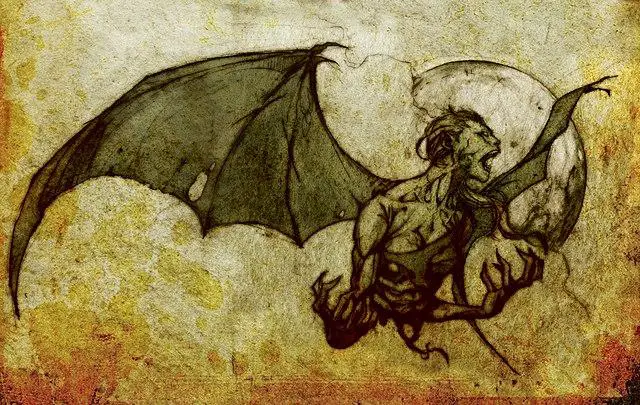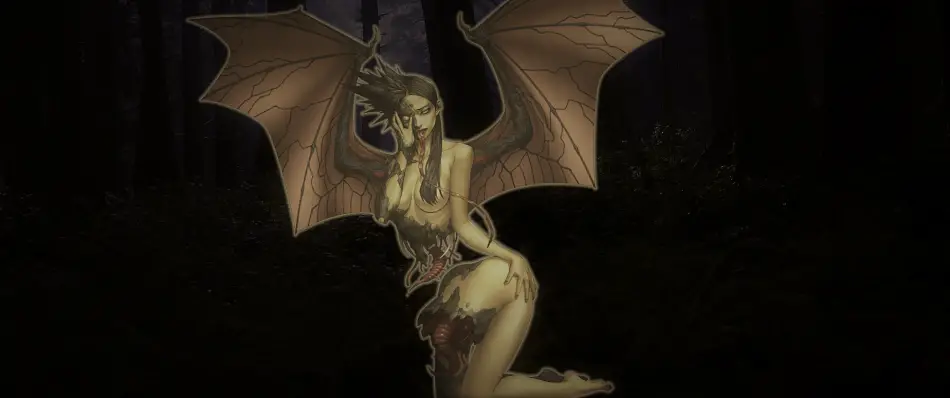Share the Lore!
By: Alex Postrado
A Vampiric Horror of Philippine Lore
People around the world often say that it is when night falls that supernatural creatures and elemental beings start to come out.
In the Philippines, it’s no different — especially in the provinces.
Traditionally, when the clock strikes six in the evening, you can be certain that lola — your grandma — will automatically begin gathering the family inside the house, and making sure that all the doors and windows are locked.
This has been a long-established practice in families around rural areas because it is believed that there are dangerous — sometimes, man-eating — creatures lurking at nighttime.
Aswang. Kapre. Tikbalang. Duwende.
And perhaps, the grossest monster of them all, the Manananggal.
A vampiric, bat-like half of a being — because they detach their upper torso from the rest of their body — that likes to feed on the insides of their prey.
Wanna know more about them?
What is a Manananggal?
The name came from the Tagalog word, “tanggal” — meaning, “to detach” or “to separate“.
So, in a literal sense, Manananggal means “one who detaches“. And there’s no need to ask why.
If you look up drawings of this vicious monster, you would see that her body is severed around the waist.
Yes, that causes her guts to dangle in the open. And yes, I used the word “her” because she is typically depicted as a female.
Though, the Manananggal is not known to only be a single entity. There are other Manananggals out there and they are believed to hunt for victims at night — particularly when everyone is already asleep. How?
First, the Manananggal separates herself from the human parts of her body. This means everything from the waist down.
Then, she grows huge, bat-like wings to fly around, and an elastic tongue so long and sharp that it is able to puncture holes through the roof of her victim’s house to ultimately — and disgustingly — tear through their flesh.
She does this because she is said to be craving human insides. And even if she only stays on the rooftop throughout the whole ordeal, her flexible tongue can still find its way to dinner.
Pregnant women are believed to be the ideal prey of the Manananggal.
If she finds one, she would patiently wait for an opportunity to attack and when it’s time, she would slowly lower her tongue to the navel of her target and suck out basically everything — from the woman’s heart, intestines, other internal organs, and her unborn child.
The appearance of the Manananggal is often — if not always — accompanied by her birdlike companion, the Tiktik.
This flying beast got its name from the sound that it makes: “tik-tik-tik-tik“. And according to the lore, its presence is meant to confuse the poor victims.
The thing is, if a person hears an ominous sound — like that of the Tiktik — the normal response would be to run the other way or to hide.
But, in the case of the Manananggal-Tiktik tandem, you would need to go against your natural instinct if you want to survive.
A useful hint? The louder the Tiktik’s sound, the farther the Manananggal is.
So, run if you can. And don’t wait for the birdcall to grow fainter.
Aswang Vs. Manananggal
If there is a monster in Philippine folklore that is more famous than the viscera-sucking Manananggal, it is probably the Aswang.
If you’ve already heard of them, however, you might be thinking: aren’t they the same?
Even some Filipinos use these two terms interchangeably. And the confusion likely stems from dialectal translations over the years.
If truth be told, though, the two are similar, but not the same.
Aswang is an umbrella term for a slew of sinister, shape-shifting creatures in Filipino folk stories.
There are five types of Aswang, namely: the vampire, the weredog, the ghoul, the witch, and the self-segmenting, viscera-sucker.
You already know which one is the Manananggal.
Simply put, the Manananggal is a subspecies of the Aswang — and quite possibly, the most evocative among the group.
How to Spot a Manananggal
During the day, the Manananggal is said to assume the form of an ordinary human.
Usually described as a beautiful woman, she relies on this deception to search for her potential prey as she mingles with people and carries out normal day-to-day tasks.
Some accounts also say that Manananggals can even marry humans if they want.
However, if you happen to be on the unfortunate end of the plotline, you might be the undoubting victim lured into the forest at night by the Manananggal’s seduction.

For the most part, there really isn’t much of an indicator to help you pick out a Manananggal in her human form among a crowd.
But, at nightfall, banana groves are your best bet.
It is commonly the hiding spot for her lower body — other than abandoned yards — because, from a distance, human legs could look like banana tree trunks.
Good for her because she really needs to hide that lower half well. Why?
How to Kill a Manananggal
There is a ritual that can transform a regular person into a Manananggal and that involves some oil and a certain black, baby chicken.
It begins with the human, rubbing a special oil or ointment onto her body.
She will, then, need to chant an incantation and thereupon swallow a black chick that — as if an heirloom — came from an older Manananggal — usually a relative — and was formerly raised inside her throat.
If the ritual is performed correctly, the human — as the lore says — would become a Manananggal.
There still are ways to undo that, if you — by any chance — want to save someone from becoming a vampire-like monster.
The cure is to tie her upside down to a tree and spin her around or beat her with sticks till she vomits the infection up.
It might sound brutal in a way, but it is believed to be customary to prevent the chick from maturing into a full-grown bird which would then — eventually — transform the person into an actual Manananggal.
If all of your efforts still fail, there is, unfortunately, no coming back for her.
You only have two options:
Kill her by stabbing her upper body from the back; or find her lower half and sprinkle salt, pepper, crushed garlic, ashes, vinegar, or other spices on the exposed flesh to prevent her from combining again.
If by sunlight, she still hasn’t reattached her upper half to the rest of her body, she will immediately die.
Alleged Manananggal Sightings
Today, most Filipinos — especially those who live in the cities — no longer believe in Manananggals.
However, in some barrios and the surrounding countryside, the belief in this fetus-devouring fiend still remains intact and some of them purportedly have encounter stories to tell.
One Manilyn Gaspar shared her alleged brush with a Manananggal while she was pregnant. She reported an “all white and scary” monster, hovering around despite her, sprinkling the entire house with salt.
Other Manananggal sightings are also being featured by media even to this day due to the scare factor it gives the audience.
But the most notorious Manananggal incident in the Philippines, by far, was the one that happened in Tondo, Manila around 1992 when a woman named Martina Santa Rosa was allegedly attacked by a naked, flying upper body of a woman.
Eyewitnesses and other victims of the Tondo encounter recalled their experience on live television and it all soon became a talking point.
News that highly alarmed everyone, causing even international newspapers to cover the sighting.
The Tragic Truth to the Monster
The Manananggal has been flying around for ages now — with records, dating to as far back as the 1500s.
The earliest, being when conquistador Miguel de Loarca reported a disembodied, viscera-taker in his work around 1582.
However, prior to the arrival of Spanish fleets in 1521, myths about deities and other supernatural creatures already existed in the pre-colonial Philippines.
Regrettably, though, most of those stories are now lost in history.
An important part of the Indigenous Filipino culture, wiped clean from shared memory by the introduction and spread of Roman Catholicism during the centuries-long Spanish occupation.
Similarly, folkloric narratives weren’t the only thing affected by Spanish colonialism. Societal roles and perspectives were slowly altered, too.
Tailored to match the colonial beliefs, ultimately helping them convert and “cleanse the land of heathens“.
Indigenous Filipino culture regarded women as a valuable part of their society — with their crucial roles in healing, spirituality, leadership, and childbirth.
But that custom did not align with the teachings brought by Spanish conquistadors and missionaries. And their eventual rise to power caused a dramatic turn of events for Filipino women.
The babaylans or priestesses, the healers, the mediums, the midwives — women who once held a strong influence upon their communities were recast as witches and monsters in carefully crafted stories like that of the Manananggal.
This was something the Spanish did to discredit the native female power — reversing the story and portraying women as fetus-eaters rather than matriarchal figures.
With bodies split in half, detached from their sexual organs, as if alluding to the idea that a woman who claims control over her own sexuality is unquestionably evil — and is, therefore, a Manananggal.
A blood-thirsty, organ-sucking monster of Philippine lore.
Is the Manananggal Real?
In spite of all the rumors and alleged sightings, the Manananggal is still widely considered a folkloric creature in Philippine stories.
To this day, there remains no substantial evidence to prove her existence. And until we have that, the Manananggal will likely continue to be the appalling representation of postcolonial Filipino fears.
Part-human and part-monster — as though mirroring how Filipinos still carry their forgotten ancestral beliefs while embracing the foreign faith and customs brought to their land centuries ago.
References:
Manananggal - Philippine Tales The Myth of the Manananggal Manananggal - Philippine Myths and Legends Aswang: The hair-raising Filipino mythical monsters (epic guide) Manananggal - Paranormal Papers Performing the Body in Filipino Narratives Witches In The Philippines, Or Spanish Propaganda? B.C. authors are taking back the monsters of Filipino folklore from colonial influences

